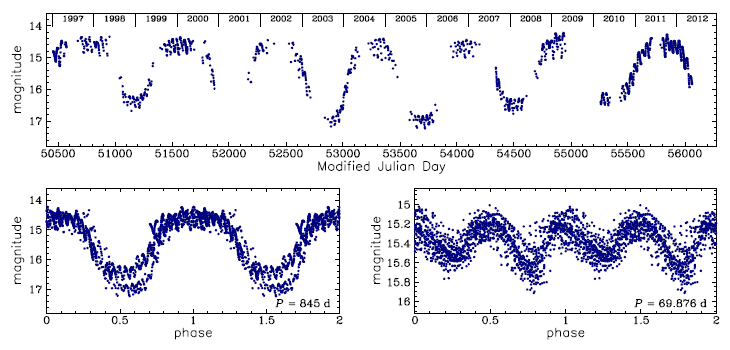RV Tauri stars
RV Tauri stars belong to the family of type II Cepheids, but their light curves are quite unusual for radially pulsating stars. A defining characteristic of the RV Tauri stars is a light curve which displays alternating deep and shallow minima, thus sometimes they can be confused with eclipsing binaries. In some RV Tauri stars the maxima also exhibit alternations. In these stars the higher maxima follow the deeper minima. The formal periods (time intervals between successive deeper minima) are in the range from about 40 to over 100 days. The amplitudes of their visual light curves are usually larger than 1 magnitude. Below we present eight phased light curves of RV Tauri stars detected by the OGLE project in the Galactic bulge and Large Magellanic Cloud. The light curves are scattered because of their semiregular nature - they usually show considerable variations from cycle to cycle and this behavior is generally more pronounced for the longer-period RV Tauri stars. Note the different shapes of the light curves, in particular the different relative depths of the minima.
In some RV Tauri stars interchanges of deep and shallow minima occur. As an example of such behavior we present OGLE-IV light curves obtained in three consecutive years (2010-2012) for one of the RV Tauri stars (OGLE-BLG-T2CEP-034) in the Galactic center. In 2010 this star exhibited deeper and shallower minima, that became almost equal in 2011, and swapped with each other in 2012. Move the cursor over the image to see this effect.
RVb stars
RV Tauri stars are divided into two photometric subclasses: RVa stars which maintain a roughly constant mean brightness (all the light curves presented above belong to this group) and RVb stars which exhibit additional long-period variation superimposed on the pulsation light curves. Examples of such behavior are shown below. Light curves of each RVb star are presented in three panels: in the upper panel the unfolded original light curve is plotted, in the bottom left panel the same light curve folded with the long period is shown and in the bottom right panel there is an RV Tauri light curve obtained by subtracting the long-term variability. First, we present the photometry of an RVb star from the Large Magellanic Cloud (OGLE-LMC-T2CEP-200) collected by the OGLE project from 1997 to 2012 (OGLE-II + OGLE-III + OGLE-IV). Note the large and variable depth of the long-term modulation.
 |
This RVb star - OGLE-BLG-T2CEP-345 - has a different (although variable) shape of the long-term modulation:
This RVb star identified by OGLE in the Galactic bulge - OGLE-BLG-T2CEP-177 - is an absolute record holder in the length of the long-term variations. The long period is equal to about 7.8 years, thus the OGLE observations since 2001 covered only about 1.5 of the cycle.
And finally we present an RVb star which turned into an RVa star. The observations from 1992-1999 obtained by the MACHO project show RVb long-term variability with a period of about 960 days. The OGLE observations since 2001 reveal this periodicity, but with a very small and decreasing amplitude.
Yellow semiregular variables (SRd stars)
Sometimes the interchanges of deep and shallow minima are so frequent and the irregular component of the light curve is so large that the alternations of minima are not detectable. Such objects are called yellow semiregular variables or SRd stars. There is no doubt that SRd stars are closely related to RV Tauri stars. Both classes are represented by old, low-mass, pulsating super giants, populating the same range of magnitudes and colors and obeying the same period-luminosity relation. Below we present three examples of SRd stars from the Galactic bulge. Left panels show unfolded light curves obtained between 2010 and 2012, while right panels show the same light curves folded with the pulsation periods (note that these periods correspond to half the formal periods of RV Tauri stars).
| 